Vigilance is Key to Preventing a Bite
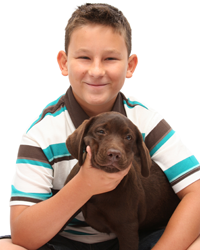
The AVMA estimates that of the children under the age of 18 who have been bitten: family dogs are responsible for 30% of the bites, while the neighbor’s dog is responsible for another 50% of the bites. Never assume because the child and dog know each other that they are fine together.
Whether you have a dog or not, take a minute to read over these helpful tips to preventing dog bites from Heidi Ganahl, CEO and founder of Camp Bow Wow. We all encounter dogs almost daily.These 10 tips might just save you a trip to the hospital. It might also save your dog’s life – many times an offending dog will be euthanized.
Pet Personalities. Dog owners should always understand (through training) their dog’s personality and limitations. Owners should not put dogs into situations where they feel anxious, nervous or afraid – this is a recipe for a dog bite encounter. Most aggression is fear-based and most bites are preventable if the owner takes some time to understand their dog.
Pets and Socialization. Socialize your pet at early stages in his development. This will allow your pet to feel at ease around people and other animals in social settings. Socializing your dog can have a tremendous effect on his interactions both at home and in public. Newly socialized dogs become calmer, friendly, affectionate, and can adapt better to a new environment.
Training Techniques. Train your dog or hire a professional to do so. Basic commands such as “Sit” and “Stay” help dogs understand what is expected of them. Training can also be incorporated into fun activities that establish the owner as an authoritative figure, yet strengthen the bond between owner and dog as companion and friend.
Space and Body Language. Respect the dog’s space. Never stand over a dog or stare at the dog while hovering above him. This is a direct threat in the dog’s language and may provoke a bite because the dog is afraid or intimidated.
Pets and Children. Children are the most common victims of dog bites. Never leave a child under 10 years old alone with a dog, no matter how much you trust your four-legged friend. Children should always ask before petting a dog, and parents and dog owners should observe and supervise the interaction between dog and child with even the most child-friendly dog.
Children and Aggressive Behavior. Children should never get in a dogs face or grab the dog in an aggressive way. Dogs tend to give warnings when they are uncomfortable and may bite in response. In most cases, children aren’t able to pick up on these signals and can easily get hurt.
Dogs in Chains. Never chain or tether your dog in the backyard or any other area. Dogs who are chained up feel increased levels of stress and protectiveness. A dog that is confined and feels threatened will defend himself and is more likely to bite.
Security in Public. Pet owners should always use a leash to ensure that they are able to control their dog in public settings. If the pet becomes excited or anxious for any reason, pet owners should draw him near and gently pat his head or rub his fur to calm him down.
Security at Home. If your home has a fenced yard, make sure gates are always secure. This will prevent Fido from running off into public spaces and interacting with others without your supervision.
Pet Health. A healthy pet is a happy pet. Make sure that your dog visits a veterinarian annually, receives proper exercise, and is vaccinated against rabies and preventable diseases. Remember, how your dog feels affects how he behaves.
View the DogChannel behavior center for more signs and corrective actions for dog’s that bite. More>>
The following are tips provided by the CDC on what to do if you or your child is bitten:
Rinse the bite area with soapy water.
Elevate limb(s) that have been bitten.
Apply antiseptic lotion or cream. Watch the area for signs of infection for several days after the incident.
For deeper bites or puncture wounds, apply pressure with a clean bandage or towel to stop the bleeding. Then wash the wound, dry it and cover with a sterile dressing. Don’t use tape or butterfly bandages to close the wound.
It’s a good idea to call your child’s physician because a bite could require antibiotics or a tetanus shot. The doctor also can help you to report the incident.
If your child is bitten severely, call 9-1-1 or go to the emergency room.
When going to the emergency room, advise the personnel of:
a. your tetanus vaccination status
b. vaccine status of the dog
c. who the dog owner is; and
d. if the dog has bitten before
Remember, vigilance is key in any situation where your dog is around other people and animals. Never assume you know what your dog is going to do – that’s like assuming you know what the person next to you is thinking or going to do – it’s a recipe for disaster.
Dog Peeing When Excited
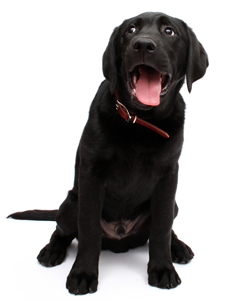
It is fairly common in young puppies who have less control over their bladder and are easily excited, though it usually goes away as the dog matures. Some dogs, however, continue this habit into adulthood. This behavior tends to be more common in female pups, but it can happen with males, too.
Why dogs pee when excited
When a puppy becomes overexcited, or when something frightens her, it’s normal for the pup to release a few drops of urine. Not all puppies do this, but many do. It happens because overexcitement or fear may cause the pup to momentarily lose control of the muscles that close the urinary bladder, which allows a small amount of urine to escape.
This is a physiological response to excitement and is not under the pup’s control. She might not even realize it’s happening until she feels a sensation of wetness.
Why this dog behavior is a problem
Cleaning up puddles every time you greet your dog can be frustrating and distressing to owners. The first reaction is often to scold a dog for the behavior, but it is not the dog’s fault. Punishing a dog for this behavior is useless and cruel, because the dog cannot control the leakage.
Scolding or showing disapproval can make the dog more anxious and cause the problem to get worse – sometimes turning a temporary age or health-related behavior into a long-term nervous habit.
How to keep your dog from peeing when excited
Reduce the initial excitement. The most common trigger for urination while greeting is loved ones arriving home after being gone for several hours. To reduce the dog’s excitement, walk into your house without greeting her. Put down your purse or other items you’re carrying and put your coat away. Delay greeting her until about five minutes after you’ve arrived home.
Keep greetings low key. Speak quietly and calmly when you greet your dog. Don’t immediately bend down to pet her, as “looming over” a dog in that way can trigger them to urinate. Instead of reaching for her, just put your hand where she can come to it for petting. Pet her under the chin, not on top of the head. Teach your visitors to do the same.
Greet outdoors. If your dog tends to pee when you first say hello to her, say hello outdoors. This way the dog will be urinating where there’s no need to mop it up. That will reduce your own anxiety about the possibility of a wet greeting and you’ll relax a bit – which can help reduce any anxiety your dog might have learned to feel about greeting time.
Health check. Though usually outgrown by six or seven months of age, this behavior can linger into adulthood. Sometimes health issues, such as urinary tract infections, can cause delayed bladder control, so if your dog is over five months old and still piddling when petted, let your veterinarian know. If it’s a health problem, it needs to be treated medically. Most often, though, there are no health issues causing the problem – it’s just a case of too much excitement.
Dog Pulling on Leash
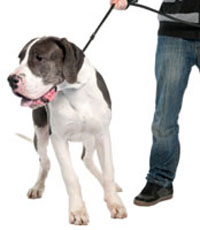
A dog pulls on the leash for several reasons:
• Sees, hears, or smells something exciting.
• Excess energy makes it hard for her to contain herself.
• Through experience, realizes that pulling on leash makes the handler walk faster or go the direction she wants.
• Because she can.
Why this dog behavior is a problem
Pulling on leash can start off innocently, but can become a problem for both the dog and the handler. The added pressure of the collar against the dog’s windpipe (trachea) can cause wheezing or coughing, which may be only temporary, or may cause long-term or even permanent damage to the dog. A dog who pulls strongly can cause the handler to lose balance and slip or fall. Strong leash pulling by a large dog, especially near roads with traffic, can lead to serious accidents.
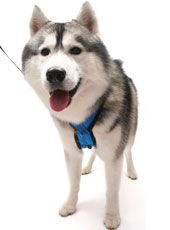
Changing from a neck collar to either a head halter or front-attachment body harness can bring an immediate solution to leash pulling. These tools provide a mechanical advantage for the handler and do not cause pain for the dog. Using a head halter or front-attachment harness immediately allows the handler to control the direction and speed of the dog, without needing a lot of physical strength to accomplish this, but the dog still needs to learn how to walk politely, without pulling at all.
Teaching your dog to walk on a leash
A good way to teach loose-leash walking to a dog who pulls on the leash is to show her that pulling no longer “works” they way she thinks it will. When your dog starts to pull, simply stop walking. Stand still and wait for your dog to realize she’s not getting anywhere.
If your dog continues to pull after you’ve been stopped for three seconds, start very slowly walking backwards. Your dog will realize she’s losing ground now, not gaining it. When the dog turns around to look at you, wondering what’s gone wrong at your end of the leash, the leash will loosen a little bit. At that point, you can praise her and start walking forward again.
By consistently repeating this process each time she pulls, she will start to realize that pulling activates your “brakes” and not your “accelerator,” and the frequency of pulling will gradually diminish and eventually disappear.
Once your dog understands how to walk without pulling when wearing a head collar or body harness, you’ll be able to re-introduce her to walking politely while wearing an ordinary collar.
Dogs That Dig Furniture
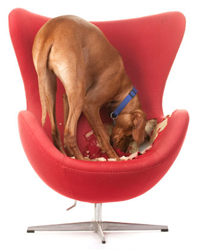
The ancestors of our modern dogs had no comfy beds or couches to lounge on, of course, so when they wanted a comfortable spot to lounge, they’d simply make one.
Dogs today retain the instinct to do that. Dogs who spend time outdoors will dig a nest-like depression in the soil or dry grass that comfortably fits their body contours, and lounge there, alternately napping and surveying their territory.
Why a digging dog can be a problem
When indoors, this instinct is still active, and dogs will try to arrange the surface where they wish to lounge to fit their body. If this means digging a hole in the seat of your brand new lounge chair, the cost to repair or replace that cushion will never even enter your dog’s mind.
How to live with a dog that digs
One possible answer is obvious – keep the dog off the furniture, period. Provide your dog with her own personal blankets and pillows that you do not mind getting ruffled up.
If you wish to allow your digging dog to share your comfy furniture, but don’t want her to dig into it, lay a blanket or other durable fabric on the seat, with the edges tucked down around the sides of the cushion. When your dog indulges her instinct to dig a nest, she will untuck the blanket and rumple it up, instead of trying to dislodge and rumple the upholstery.
Flying With Dogs

“Everyone within a mile of us is now hearing the frantic barking of what appears to be a completely insane Tasmanian devil disguised as a Min Pin. She was barking like she was going to attack someone — anyone,” recalls a mortified Christner. Her foster dog crooned at her feet throughout the flight — despite medications approved by her veterinarian, but often discouraged by others, including the American Veterinary Medical Association.
“She barked and clawed at the [bag’s] netting to actually make a hole so she could stick her head through,” Christner says. Ignoring a chew toy, the pooch “chewed on my shoe.”
The experience taught Christner some lessons about the right and wrong way to pursue canine air travel — a subject that divides animal lovers.
To fly or not to fly?
Breeders and dog fanciers routinely fly dogs without trouble. Airlines assert that air travel is safe for dogs, as does the Air Transport Association of America. But American Kennel Club spokesperson Lisa Peterson adds a caveat: “We certainly believe it’s safe to fly with your dog on any commercial airline flight, provided the owner takes certain pre-flight precautions.”
Several humane organizations and some veterinarians warn of hazards for dogs in the cargo holds of planes, citing incidences of dogs injuring themselves as they claw at the crate to try to escape or escaping when crates open accidentally on a tarmac. Don’t fly pets if possible, especially if the pet isn’t small enough to fit in a carry-on kennel you can take into the cabin, advise the American Society for the Prevention of Cruelty to Animals and the Humane Society of the United States.
Since record-keeping by the U.S. Department of Transportation began in May 2005, 30 pets became injured during air transport, 17 pets became lost and 49 pets died, according to a DOG FANCY review of federal records as of March 2007.
“I much prefer having the dogs travel with the owner inside a car or van because they can take breaks when appropriate, stretch their legs, and are being handled by people who know and love them,” advises Texas A&M University animal behaviorist Bonnie Beaver, DVM, American College of Veterinary Behaviorists diplomate, and past president of the American Veterinary Medical Association. “While many dogs travel successfully by air, I know of the horror stories where problems occurred.”
But, recognizing flying is sometimes unavoidable, experts advise that there is a lot to think about if you’re going to try it.
Practical advice
1. Definitely fly your puppy in the cabin as you coo and feed him tiny treats like beef extract on the tip of your finger, advises Tufts University veterinary behaviorist Nicholas Dodman, BVMS, a diplomate of the American College of Veterinary Anesthesiologists and the American College of Veterinary Behaviorists.
For a young pup during the crucial formative time in his life, being jostled in a cargo hold as a noisy plane takes off and lands is akin to taking Mr. Toad’s Wild Ride at a theme park. Any “horrendous experience,” Dodman says, “can have long-lasting, lifetime effects.”
2. Choose the quickest direct early-morning or evening flight to ensure your dog travels when temperatures are favorable in the cargo hold and on the tarmac — and fly direct to ensure he doesn’t end up in a different city from you. Avoid flying during extreme weather — hot or cold.
“In general, I discourage people from flying with dogs that cannot actually be in the cabin with them,” Beaver says. “There are air traffic delays that can become real problems, and I certainly discourage dogs from flying if there is not a direct connection from origin to destination. Humans have enough problems making connections.”
3. When buying a crate or kennel, be sure it’s large enough for your dog to stand up, turn around, and lie down in. Look for a sturdy one with locking bolts and strong metal doors. The strongest have four metal rods that fasten the door to the container, the federal government says. Further secure the door by adding tie wraps that can be cut in an emergency.
Many injuries, deaths, and escapes happen when dogs chew their way out of a plastic crate, push the door open, or take advantage of a broken or improperly latched lock. For example, a Golden Retriever named Skipper “lost teeth, cut his gums, and lost toe nails” as he chewed and scratched to try to get out of his kennel during a cross-country flight to Seattle in June 2006, according to a Continental Airlines report to the federal government. When another dog — a Greyhound named Gianna — arrived on a December 2006 Alaska Airlines flight to Seattle, she was discovered with her mouth and jaw stuck on the front gate of her kennel.
4. At home, get your pet accustomed to the travel carrier or kennel for at least one month, lest he put up a fight like Christner’s Cricket.
Joan Carlson, executive director of Florida’s Humane Society of Vero Beach & Indian River County, took deliberate steps to acclimate her cousin’s new mixed-breed puppy, Little Bella, for a flight from Orlando to Philadelphia: She put special treats and toys in the carrier, as well as Bella’s meals. She let Bella walk in and out of the carrier at will. Gradually, as days wore on, Carlson closed the carrier to make Bella stay inside for a short time, then increasingly longer periods. Carlson eventually took Bella in the carrier on a short car ride to get her accustomed to the idea of motion. When the pair finally flew, Bella “was a little whiny at first,” Carlson says, but “it was her safe place. It was very easy to adapt to being in a crate and being on a plane.”
5. Don’t assume your pet will be accepted on the flight. Reserve a space for your dog — whether he travels in the cabin or in the cargo hold. Airlines have limited spots for animals.
6. Be sure your dog is fit to travel by getting him checked by a veterinarian a week to 10 days before your trip, as airlines require. Realize that pre-existing conditions could become a problem anyway. For instance, older dogs can have borderline kidney disease without their owners realizing it. They compensate by drinking lots of water, Dodman says. If such a dog gets on an airplane without free access to water, Dodman says, “you can precipitate renal failure.”
7. Don’t feed your dog for four to six hours before flight time, HSUS advises. A small amount of water before the trip is OK. Freeze a margarine tub filled with water and place that ice — not water — in the kennel’s water tray. That way, water won’t dump into the kennel and onto your pet, but hydration will be available as the ice melts.
8. On your dog’s collar, attach two pieces of identification — a permanent ID with your name and home address, and a temporary ID with the phone number where you can be reached during your travels. Also helpful: a microchip or tattoo as permanent ID. The more ID, the better.
Know your dog
As with many situations, it’s important to trust your gut when considering flying your dog. If you suspect your dog is a nervous Nellie who couldn’t take the flight, you’re probably right.
The drug maker Novartis Animal Health estimates that 15 percent of dogs suffer from some degree of separation anxiety, which, Dodman says, makes them poorer flight candidates. “Those dogs can’t be left alone,” he says. “They can actually chew through metal. They’re like Houdini dogs.”
Christner, for one, says her foster dog, Cricket, won’t be taking another plane trip. “I don’t think she was cut out to fly. She did not like to be confined and it made her crazy,” she says. Unless her name has been blacklisted after the Cricket fiasco, Christner says she will continue to travel with her other two dogs, “as they are true travelers.”
Electronic Collar Training Tips
Innotek, the manufacturer of a wide array of dog training equipment, suggests adjusting the collar snugly while leaving enough room to easily insert a finger between the strap and the dog’s neck.
Use the collar on clean fur and remove the collar when you are not actively training the dog, taking care not to leave it on your dog longer than 12 hours at one time. The probes on the collar may result in a rash or sores if the collar is too tight or if it is on the dog’s neck too long.
Remove any other collars before fitting your dog with an E-collar. Metal clasps and dog tags may interfere with the efficiency of the receiver.
Training Session
Determine a behavioral goal and employ repetition during the training session. For instance, if your dog barks every time the doorbell rings, recruit an assistant to ring the bell a few times over a period of 15 minutes. When the doorbell rings and your dog barks, issue the command “Shush” and depress the transmitter briefly to reinforce your command.
Begin with the lowest stimulation level on the collar and increase it slightly if your dog does not respond. Some dogs will tolerate a strong shock, while others will become agitated by a low level of stimulation.
Avoid continuous stimulation; just a small shock will suffice. Continue the training sessions daily until your dog sits quietly when the doorbell rings.
Along with the collar, use treats to reinforce positive behavior. Even if your dog barks when the doorbell rings, praise him when he becomes quiet and give him a treat.
Warnings
Not all trainers approve of using E-collars because a dog may not understand why he is receiving the shock, and he may become anxious or fearful. Electronic collars should not be used as punishment. In addition, puppies under 6 months old may not be mature enough for this type of training. Verbal commands must always be used in conjunction with an E-collar.
Spray Bottles for Dog Training
Pros of the Spray Bottle
You can keep bottles all over your home so you always have one ready if Bubba misbehaves. Water is harmless — you’re not being mean, just distracting your buddy from doing something he shouldn’t. Some dogs become so fearful of it that they’ll take the long way around the room if they see the bottle on the table — you might not even need to use it.
The Downside
Your pal may become terrified of water. He’ll have no problem drinking it, but when it comes to bath time, forget it. Water is scary, so when you try to lure him to the tub, he may growl or snap. If Bubba seems terrified of the spray bottle, it probably isn’t an ideal tool for your situation. On the other hand, some pups couldn’t care less about the water and make it a game by trying to catch the stream in their mouths.
Training Tips
The trick to making the spray bottle effective is to not make a big fuss. It’s not meant to be mean or a way to tease your dog. If you see bad behavior, grab the bottle, give him a squirt and put it back down — ideally he shouldn’t see you pulling that trigger. Then toss him a toy to chew on and pat him on the head to enforce the desired behavior.





